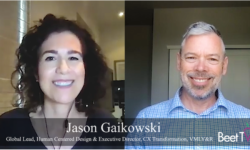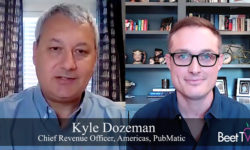There’s a growing theory that diminishing views to ad-funded content may be offset by increased effectiveness from targeting and personalizing those ads.
But that is only going to come about if ad production and delivery channels are themselves wired up to support this addressability.
In this video interview with Beet.TV, Anush Prabhu, US Chief Strategy Officer and Global Chief Strategy Officer, Creative Transformation, for MediaCom, describes what it’s going to take – and how it will help.
Personally relevant
Prabhu sees a world in which consumers are increasingly happy to share private data with brands. But he thinks brands have to catch up to that.
“Right now, about 80% of our media is addressable whereas only 2% of that content is being addressed,” Prabhu says. The reason?
“Brands have found it very difficult – from a production, from an operation perspective, from an optimization perspective – to do it themselves.”
“That is the opportunity we see for marketers tomorrow – to get a lot more personally relevant with their messaging with their media.
Performance boost
That personal relevance could move the needle, Prabhu thinks.
“The fact is that media (inventory) in any system only accounts for 50% of the impact of any marketing, the other 50 still rests with creative.”
He says brands that do engage in a lot more personal, relevant messaging can see over 45% increase in their performance.
“We need to make a lot of strides there and bring the opportunity that we have gone into from a media perspective into the creative world as well,” he explains.
Executing dynamic
Despite years of talk about dynamic creative optimization (DCO), the art of re-mixing ad creative assets into new versions for different audiences, Prabhu’s message will come as a shot in the arm. He is saying it’s time for ad creative to get personal, to resonate with a splintering range of audience and to boost effectiveness.
And he thinks the route to that future has two lanes:
- Production: Prabhu’s MediaCom is tapping tools like WPP Open and Flashtalking to produce creative in many versions connected to foundational insights.
- Optimization: Then he wants to understand which versions are working. “There are so many variations within those messages, whether it’s the right colour, do we have people in it?,” he asks. “How much of the product should be seen? All those aspects get even more complex when you add the different audience variations.”
It is all so important because, if consumers as individuals weren’t already distinct enough to merit personalized advertising, cultures are.
“So far, media and the world of advertising and marketing has been very biassed towards the majority, but that majority is changing,” Prabhu says. “The new majority today is going to be those ethnic populations, diverse people with different skin colours, different choices.
“Not only in terms of the way they live their lives, the way they approach religion, the way they approach their sexual preferences. Making sure we as a media industry or an advertising industry connect and equally treat all those opportunities for every brand is key.”














































